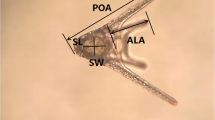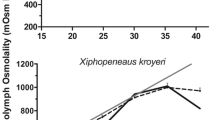Abstract
Embryos and larvae of two species of sea urchin,Strongylocentrotus purpuratus andLytechinus pictus, and larvae of the brine shrimpArtemia sp. (San Francisco brand) were cultured to investigate the contribution of dissolved organic material in seawater to the energetics of early development. When embroys ofS. purpuratus were reared in artificial seawater, a net loss in dry organic mass was observed. In contrast, when sibling embryos were reared to Day 2 under identical conditions in natural seawater, there was either a net increase in dry organic mass or no change. A net decrease in mass was observed in only one of five cultures reared in filtered natural seawater. Energy budgets for each species were determined by giving energy equivalents to the changes in carbohydrate, lipid and protein, and to the rate of oxygen consumption for each day of development. In the case ofS. purpuratus, the use of endogenous reserves accounted for either 0 or 38% of the metabolic demand for two independent cultures reared from Days 0 to 2. For larvae ofL. pictus, reared to 8 d, only 66% of the metabolic demand could be accounted for by the use of endogenous reserves. Sea urchins are capable of transporting dissolved organic material from seawater. Calculations revealed that the energy deficit during the early development of sea urchins (S. purpuratus) could be accounted for by the uptake of dissolved organic matter from seawater. However, for a species that cannot use this resource (Artemia sp.), the metabolic needs during development are supplied through the use of endogenous reserves.
Similar content being viewed by others
Literature cited
Anderson, J. W., Stephens, G. C. (1969). Uptake of organic material by aquatic invertebrates. VI. Role of epiflora in apparent uptake of glycine by marine crustaceans. Mar. Biol. 4: 243–249
Bayne, B. L., Holland, D. L., Moore, M. N., Lowe, D. M., Widdows, J. (1978). Further studies on the effects of stress in the adult on the eggs ofMytilus edulis. J. mar. biol. Ass. U.K. 58: 825–841
DeBurgh, M. E., Burke, R. D. (1983). Uptake of dissolved amino acids by embryos and larvae ofDendraster excentricus (Eschscholtz) (Echinodermata: Echinoidea). Can. J. Zool. 61: 349–354
Cavanaugh, G. M. (ed.) (1956). Formula and methods, IV, of the marine biological laboratory chemical room. Marine Biological Laboratory, Woods Hole, Woods Hole, Mass.
Davis, J. P., Stephens, G. C. (1984). Uptake of free amino acids by bacteria-free larvae of the sand dollarDendraster excentricus. Am. J. Physiol. 247: R733-R739
Emlet, R. E., McEdward, L. R., Strathmann, R. R. (1987). Echinoderm larval ecology viewed from the egg. In: Jangoux, M., Lawrence, J. M. (eds.) Echinoderm studies. Vol. 2. A.A. Balkema, Rotterdam, p. 55–136
Epel, D. (1972). Activation of an Na+-dependent amino acid transport system upon fertilization of sea urchin eggs. Expl Cell. Res. 72: 74–89
Gnaiger, E. (1983). Calculation of energetic and biochemical equivalents of respiratory oxygen consumption. In: Gnaiger, E., H. Forstner (eds.) Polarographic oxygen sensors, Springer-Verlag, Berlin, p. 337–345
Hino, A., Yasumasu, I. (1979). Change in the glycogen content of sea urchin eggs during early development. Dev. Growth Differentiation 21: 229–236
Holland, D. L., Gabbott, P. A. (1971). A micro-analytical scheme for the determination of protein, carbohydrate, lipid and RNA levels in marine invertebrate larvae. J. mar. biol. Ass. U.K. 51: 659–668
Huvard, A. L., Holland, N. D. (1986). Pinocytosis of ferritin from the gut lumen in larvae of a sea star (Patiria miniata) and a sea urchin (Lytechinus pictus). Dev. Growth Differentiation 28: 43–51
Isono, N., Yasumasu, I. (1968). Pathways of carbohydrate breakdown in sea urchin eggs. Expl Cell Res. 50: 616–626
Jaeckle, W. B., Manahan, D. T. (1989a). Feeding by a “nonfeeding” larva: uptake of dissolved amino acids from seawater by lecithotrophic larvae of the gastropodHaliotis rufescens. Mar. Biol. 103: 87–94
Jaeckle, W. B., Manahan, D. T. (1989b). Growth and energy imbalance during the development of a lecithotrophic molluskan larva (Haliotis rufescens). Biol. Bull. mar. biol. Lab., Woods Hole 177: 237–246
Lawrence, J. M., McClintock, J. B., Guille, A. (1984). Organic level and caloric content of eggs of brooding asteroids and an echinoid (Echinodermata) from Kerguelen (South Indian Ocean). Int. J. Invertebrate Reprod. Dev. (Amsterdam) 7: 249–257
Lucas, M. I., Crisp, D. J. (1987). Energy metabolism of eggs during embryogenesis inBalanus balanoides. J. mar. biol. Ass. U.K. 67: 27–54
Lucas, M. I., Walker, G., Holland, D. L., Crisp, D. J. (1979). An energy budget for the free-swimming and metamorphosing larvae ofBalanus balanoides (Crustacea: Cirripedia). Mar. Biol. 55: 221–229
Manahan, D. T. (1983). Nutritional implications of dissolved organic material for the laboratory culture of pelagic larvae. In: Berg. J. (ed.) Culture of marine invertebrates: selected readings. Hutchinson & Ross, Stroudsburg, Pennsylvania, p. 179–192
Manahan, D. T., Crisp, D. J. (1983). Autoradiographic studies on the uptake of dissolved amino acids from sea water by bivalve larvae. J. mar. biol. Ass. U.K. 63: 673–682
Manahan, D. T., Davis, J. P., Stephens, G. C. (1983). Bacteria-free sea urchin larvae: selective uptake of neutral amino acids from seawater. Science, N.Y. 220: 204–206
Manahan, D. T., Jaeckle, W. B., Nourizadeh, S. D. (1989). Ontogenic changes in the rates of amino acid transport from seawater by marine invertebrate larvae (Echinodermata, Echiura, Mollusca). Biol. Bull. mar. biol. Lab., Woods Hole 176: 161–168
Mann, R., Gallager, S. M. (1985). Physiological and biochemical energetics of larvae ofTeredo navalis L. andBankia gouldi (Bartsch) (Bivalvia: Teredinidae). J. exp. mar. Biol. Ecol. 85: 211–228
McClintock, J. B., Pearse, J. S. (1986). Organic and energetic content of eggs and juveniles of Antarctic echinoids and asteroids with lecithotrophic development. Comp. Biochem. Physiol. 85A: 341–345
Mohri, H. (1964). Utilization of C14-labeled acetate and glycerol for lipid synthesis during the early development of sea urchin embryos. Biol. Bull. mar. biol. Lab., Woods Hole 126: 440–445
Monroy, A., Tolis, H. (1964). Uptake of radioactive glucose and amino acids and their utilization for incorporation into proteins during maturation and fertilization of the eggs ofAsterias forbesi andSpisula solidissima. Biol. Bull. mar. biol. Lab., Woods Hole 126: 456–466
Parsons, T. R., Maita, Y., Lalli, C. A. (1984). A manual of chemical and biological methods for seawater analysis. Pergamon Press, Oxford
Schneider, E. G., Whitten, D. J. (1987). Uptake and metabolism of nucleosides by embryos of the sea urchinStrongylocentrotus purpuratus. Expl Cell Res. 168: 1–14
Scholander, P. F., Claff, C. L., Sveinsson, S. L., Scholander, S. I. (1952). Respiratory studies of single cells. III. Oxygen consumption during cell division. Biol. Bull. mar. biol. Lab., Woods Hole 102: 185–199
Stephens, G. C. (1988). Epidermal amino acid transport by marine invertebrates. Biochim. biophys. Acta 947: 113–138
Strathmann, R. R., Vedder, K. (1977). Size and organic content of eggs of echinoderms and other invertebrates as related to developmental strategies and egg eating. Mar. Biol. 39: 305–309
Turner, R. L., Rutherford, J. C. (1976). Organic, inorganic, and caloric composition of eggs, pentaculae, and adults of the brooding sea cucumberCucumaria curata Cowles (Echinodermata: Holothuroidea). J. exp. mar. Biol. Ecol. 24: 49–60
Tyler, A., Piatigorsky, J., Ozaki, H. (1966). Influence of individual amino acids on uptake and incorporation of valine, glutamic acid and arginine by unfertilized and fertilized sea urchin eggs. Biol. Bull. mar. biol. Lab., Woods Hole 131: 204–217
Williams, P. J. Le B. (1975). Biological and chemical aspects of dissolved organic material in seawater. In: Riley, J. P., Skirrow, G. (eds.). Chemical oceanography. Vol. 2. Academic Press, London, p. 301–364
Yasumasu, I., Hino, A., Suzuki, A., Mita, M. (1984). Change in the triglyceride level in sea urchin eggs and embryos during early development. Dev. Growth Differentiation 26: 525–532
Zar, J. H. (1984). Biostatistical analysis. 2nd ed. Prentice Hall, Englewood Cliffs, New Jersey
Author information
Authors and Affiliations
Additional information
Communicated by M. G. Hadfield, Honolulu
Rights and permissions
About this article
Cite this article
Shilling, F.M., Manahan, D.T. Energetics of early development for the sea urchinsStrongylocentrotus purpuratus andLytechinus pictus and the crustaceanArtemia sp.. Mar. Biol. 106, 119–127 (1990). https://doi.org/10.1007/BF02114682
Accepted:
Issue Date:
DOI: https://doi.org/10.1007/BF02114682




